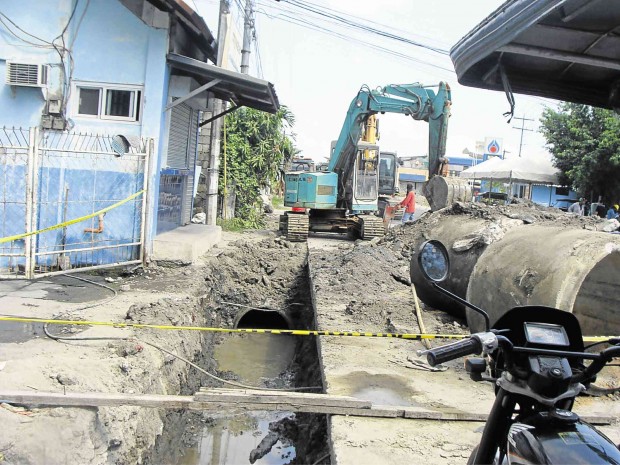
A BACKHOE helps dig up a drain that would lead to an oil pipeline that had suffered a leak, releasing foul odor in the town of Dinalupihan in Bataan province. GREG REFRACCION/INQUIRER CENTRAL LUZON
DINALUPIHAN, Bataan—A fuel pipeline, built by the US military when it still controlled what are now the Subic Freeport and the Clark Special Economic Zone, was shut down on Thursday to plug a leak, the Inquirer learned on Friday.
The pipeline was closed a day after residents of Barangay San Ramon here, complained about strong, foul odor coming from the town drains.
Cherry Pruna, 46, who operates a water refilling station, said she planned to sue because the odor drove away customers.
On Friday, liquid residue of what appeared to be petroleum had been detected in drainage canals and was being pumped out and deposited in plastic containers for testing.
The 64-kilometer pipeline was built by the American military to pump diesel, gasoline and aviation fuel to and from the former Subic Naval Base and Clark Air Base.
The pipeline was rehabilitated and is now operated by the Clark Pipeline and Depot Co. (CPDC), to pump out fuel owned by the Philippine Coastal Storage and Pipelines stationed at the Subic Freeport.
Darwin Chan, operations manager of CPDC, said initial assessment showed the pipeline was damaged by an ongoing Department of Public Works and Highways drainage project.
Chan said the breach released a small volume of fuel. “Fortunately, with the help of the local government, we were able to catch the leak as early as possible,” he told the Inquirer by telephone.
“The situation is now under control,” he said in a separate statement.
The damaged section of the pipeline is near a gasoline station here but the odor reached households 50 meters further down the area, said Wilfredo Diwa, Barangay San Ramon chief.
The pipeline runs through 20 villages here which enjoy incentives provided by Clark Pipeline.
Dinalupihan Mayor Gila Garcia said CPDC “sees to it that the pipelines are taken care of with the help of village officials.”
To trace the origin of the leak, work crews from the municipal government and the pipeline’s operator pulled out concrete culverts lining the drainage canal to get samples. This would enable the Department of Environment and Natural Resources to examine the liquid mixed with clay and mud. The samples were taken to a treatment plant in Tarlac province.